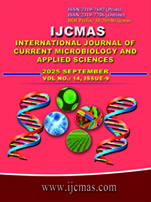


 National Academy of Agricultural Sciences (NAAS)
National Academy of Agricultural Sciences (NAAS)

|
PRINT ISSN : 2319-7692
Online ISSN : 2319-7706 Issues : 12 per year Publisher : Excellent Publishers Email : editorijcmas@gmail.com / submit@ijcmas.com Editor-in-chief: Dr.M.Prakash Index Copernicus ICV 2018: 95.39 NAAS RATING 2020: 5.38 |
In Burkina Faso, maize (Zea mays L.) is the second most cultivated cereal. However, yields remain low due to the decline in soil fertility inherent to several factors. This study was carried out in order to valorize compost and quail droppings in maize production. It was carried out in a greenhouse vegetation vase at French Research Institute for Sustainable Development in Ouagadougou. The methodology used was based on a randomized block agronomic trial with 04 treatments repeated 5 times. The trial consisted of comparing compost (3 t ha-1), quail droppings (3 t ha-1) and NPK (14-23-14-3B-1S) (200 kg ha-1) with a control. The chemical and biological parameters of the soil after harvest and the production of maize biomass were measured. The results showed that soil amendment with compost significantly increases (P = 0.006) biomass production (125.44 ± 17.13 g) compared to NPK. Compost-treated soils significantly (P = 0.0001) improved plant height (101.22 ± 8.34 cm) and number of ears per plant (0.67 ± 0.14) compared with other treatments. Plant diameter was significantly (P = 0.0001) increased under quail droppings (13.67 ± 0.51 mm). The soil treated with quail droppings improved microbial life with increased CO2 release (2715 ± 648.81 ppm) throughout the incubation period compared with the other treatments. The quail droppings amendment provided more soil organic carbon and nutrients that were easily mineralized and assimilated by plants. At result, the quail droppings improve soil biological and chemical activities or the compost increase maize biomass yield.
Andayani, S., et al., (2019). Composting of empty fruit bunches of oil palms with coastal mud and rice husk biochar to improve the fertility of acid sulfate soils. Journal of Physics: Conference Series; 1402: 31–5. DOI: 10.1088/1742-6596/1402/3/033018.
Ahenkorah, Y. (1970). Potassium supplying power of some Ghana cultivated cocoa. Soil Sci., 109, 2, 127-135. DOI: 10.1097/00010694-197002000-00008
Bacye, B., Kambire H. S, and Some A. S. (2019). Effets des pratiques paysannes de fertilisation sur les caractéristiques chimiques d’un sol ferrugineux tropical lessivé en zone cotonnière à l’Ouest du Burkina Faso. International Journal of Biological and Chemical Sciences, 13: 2930-2941. https://doi.org/ 10.4314/ijbcs. v13i6.39 .
Bado, B. V. (2002). Rôle des légumineuses sur la fertilité des sols ferrugineux tropicaux des
zones guinéenne et soudanienne du Burkina Faso. Thèse de doctorat (Ph. D.), Faculté des études supérieures de l’Université Laval, 197p. https://www.researchgate.net/publication/33955185
Barbier, E. B and Hochard J. P. (2018). “Land degradation and poverty,” Nat Sustain, vol. 1, pp. 623–631 . https://doi.org/10.1038/s41893-018-0155-4
Bray, R. H and Kurtz, L. T. (1945). Determination of total organic matter content and available forms of phosphorus in soils. Soil Science, 59, 39-45. http://dx.doi.org/10.1097/00010694-194501000-00006
Chadwick, D. R., et al., (2000). Nitrogen uptake by plants from the organic nitrogen fraction of animal manures: a laboratory experiment. J. Agric. Sci. Camb. 134, 159–168. DOI: https://doi.org/10.1017/S0021859699007510
Chianu, J., Chianu, J. and Mairura, F. (2012). Mineral Fertilizers in Sub-Saharan African Agricultural Systems. A Review. Agronomy for Sustainable Development, Springer Verlag/EDP Sciences/INRA. 32(2): 545-566. https://doi.org/10.1007/s13593-011-0050-0
Conyers, M. K and Davey, B. G. (1988). Observation of some common methods for determining soil pH. Soil Sci 145: 29-36. DOI: 10.1097/00010694-198801000-00004
Coulibaly, K., et al., (2018). Effets de l’agriculture de conservation sur la dynamique de l’eau et le stock de carbone d’un sol ferrugineux tropical à l’Ouest du Burkina Faso. Revue burkinabè de la recherche, Sciences naturelles et appliquées Spécial hors-série n° 4: 1011-6028. https://www.researchgate.net/publication/323399720
Dijkstra, F. A., et al., (2009). Does accelerated decomposition of soil organic matter in the presence of plants increase nitrogen availability to plants? Soil Biol Biochem. 41:1080–7. https://dx.doi.org/ 10.1016/j.soilbio.2009.02.013
Dipa. (2006). Agriculture Handbook: Facts and Figures for Farmers, Students, and All Those Interested in Agriculture. Directorate of Agriculture Information and Publications. Indian Council of Agricultural Research, New Delhi, p. 435. https://www.cabidigitallibrary.org/doi/full/10.5555/19810882948
Dommergues, Y. (1960). La notion de coefficient de minéralisation du carbone dans les sols. L’Agronomie Tropicale, 15: 55-60. https://api.semanticscholar.org/CorpusID:131950686
Efthimiadou, A., et al., (2010). Combined organic/inorganic fertilization improves soil quality and increases yield, photosynthesis, and sustainability of sweet corn. Aust. J. Crop Sci., 4 (9): 722-729. https://www.researchgate.net/publication/228642079
Enujeke, EC, Ojeifo, I. M and Nnaji, G. U. (2013). Residual effects of organic manure and mineral fertilizers on maize grain weight and selected soil properties in Asaba area of Delta State. International Journal of Advanced Biological Research 3(3): 433-442. Society for Science and Nature, India.
Garcia, C., et al., (1996). Characteristics of organic matter and nutrient content in eroded soils. Environ. Manage. 20:133141. https://doi.org/10.1007/PL00006696
Geng, Y., et al., (2019). Effects of equal substitutions of chemical fertilizers with organic manure on yield, dry matter, and nitrogen uptake of spring maize and soil nitrogen distribution. PLoS One 14(7): e0219512. https://doi.org/10.1371/journal.pone.0219512
Gomgnimbou, A. P. K., et al., (2019). Effets à court terme de l’application des fientes de volaille sur le rendement du maïs (Zea mays L.) et les caractéristiques chimiques d’un sol ferralitique dans la zone sud-soudanienne du Burkina Faso. International Journal of Biological and Chemical Sciences, 13: 2041-2052. https://doi.org/ 10.4314/ijbcs. v13i4.11
Hien, E. (2004). Dynamique du carbone dans un Acrisol ferrique du Centre-Ouest Burkina: Influence des pratiques culturales sur le stock et la qualité de la matière organique. Thèse de doctorat en Sciences des Sol, Ecole Nationale Supérieure Agronomique de Montpellier, France, 138p. https://www.theses.fr/2004ENSA0027
Jindo, K., et al., (2012). Root growth promoted by humic acids from composted and non-composted urban organic waste. Plant Soil (2012) 353:209-220, DOI: http://doi.org.10.1007/s11104-011-1024-3
Joseph, J., et al., (2020). Comparative Performance of Organic Fertilizers in Maize (Zea mays L.) Growth, Yield, and Economic Outcomes. Agronomy. 10(69) . 1–15. https://dx.doi.org/10.3390/agronomy10010069
Kitson, R. E, and Mellon, M. G. (1944). Colorimetric determination of phosphorus as molybdivanadophosphoric acid. Ind. Eng. Chem. Anal. Ed., 166: 379–383. https://doi.org/10.1021/I560130A017
Kjeldahl, J. (1883). New method for the determination of nitrogen. Chem News. News 48 (1240), 101–102. http://dx.doi.org/10.1007/BF01338151 .
LagBrotons, A., et al., (2014). Use of sludge compost purification in bioenergy production A Case study on the effects on the energy crop Cynara cardunculus L. Journal of Cleaner Production, 79, 32 40. https://doi.org/10.1016/j.jclepro.2014.05.021 .
Lehrsch, G. A, Sojka, R. E, and Westermann, D. T. (2000). Effects of nitrogen placement, row spacing , and furrow irrigation water placement on maize yield. Agronomy Journal, 92: 1266–1275. https://doi.org/10.2134/AGRONJ2000.9261266X
Lehmann, J., et al., (2011). “Effects of biochar on the soil biosphere – A review,” Soil Biol. Biochem., vol. 43 (9): 1812–1836. https://doi.org/10.1016/j.soilbio.2011.04.022
Mando, A. (1998). Soil-dwelling termites and mulches improve nutrient release and crop performance on Sahelian crustal soils. Drylands Research and Management, 12(2), 153-163.
Marin, J. A. (2004). Bioremediation by means of biological techniques of hydrocarbons from petroleum refinery sludge. Experiments in a semi-arid climate (Doctoral thesis, Ph. D, University of Murcia).
Melero, S., et al., (2007). Chemical and biological properties of a clayey soil in a dryland farming system affected by organic fertilization. European Journal of Agronomy. 26: 327–334. https://doi.org/10.1016/J.EJA.2006.11.004
Munyabarenzi, I. (2014). Effect of farmyard manure and mineral fertilizers on maize yield and soil properties in Huye and Bugesera districts of Rwanda. https://api.semanticscholar.org/CorpusID:130397336
Ntinyari, W., et al., (2022). “Evaluation of the 2006 Abuja Declaration on Fertilizers with Emphasis on Nitrogen: Using Efficiency to Reduce Yield Gap in Maize Production,” Front. Sustain. Food Syst. 5:758724, 2022. https://doi.org/10.3389/fsufs.2021.758724
Nyamangara, J., Piha, M. I., and Giller, K. E. (2003). Effect of combining livestock manure and mineral nitrogen on maize nitrogen uptake and grain yield. African Crops Review, 11(4), 389-300. https://doi.org/10.4314/ACSJ.V11I4.27579
Osagie, A. U and Eka, O. U. (1998). Nutritional Quality of Plant Foods. Postharvest Research Unit, University of Benin, Benin; 2(1): 34-41.
Ouédraogo, E., Mando, A., and Zombré, N. P. (2001). Use of compost to improve soil properties and crop productivity in a low-input farming system in West Africa. Agriculture, Ecosystems & Environment, 84, 259-266. https://doi.org/10.1016/S0167-8809(00)00246-2
Ouedraogo, E., Brussaard, L and Stroosnijder L. (2007). Interactions between soil macrofauna and organic amendments affect soil carbon and crop performance in semi-arid West Africa. Biol. Fert. Soils, 44 (2): 343–351 . https://doi.org/10.1007/s00374-007-0211-0
Pansu, M., and Gautheyrou J. (2006). Soil Analysis Manual. Springer-Verlag: Berlin.https://doi.org/10.1007/978-3-540-31211-6
Qiu, S., McComb, A. J., and Bell, R. W. (2008). Soil water C, N, and P ratios influence direct microbial immobilization-mineralization and N availability in nutrient-amended sandy soils in southwestern Australia. Agric. Ecosyst. Environ. 127, 93–99. https://doi.org/10.1016/j.agee.2008.03.002
Sanginga, N., and Woomer, P. L (eds.). (2009). Integrated Soil Fertility Management in Africa: Principles, Practices, and Development Processes. Nairobi: Tropical Soil Biology and Fertility Institute of the International Center for Tropical Agriculture.
Sanon, A., et al., (2023). Carbon and nitrogen mineralization of a lixisol in the South Sudanese zone of Burkina Faso. Sciences Agronomiques, 14, 1547-1560. https://doi.org/10.4236/as.2023.1411100
Sharma R., et al., (2019) Response of maize (Zea mays L.) hybrids to different levels of nitrogen. Archives of Agriculture and Environmental Science 4: 295- 299. https://dx.doi.org/10.26832/24566632.2019.040306
Singh, S., et al., (2023). Effect of biochar treatments on improving soil acidity, crop performance and soil properties; April Ama, Agricultural Mechanization in Asia, Africa & Latin America 54(4):13575-13603 . https://dx.doi.org/10.5281/zenodo.8157837
Sonetra, S., Borin, K., and Preston, T. R. (2002). Wastewater from rubber processing as a water fertilizer. Spinach and cassava fodder. http://www.utafoundation.org/utacanbod/msc99thes/sonintro.htm
AU/SAFGRAD. (2010). Recherche et développement agricoles dans les zones semi-arides d’Afrique. Technologies agricoles au Burkina Faso. Recueil des technologies agricoles,100p. https://doi.org/10.4314/ijbcs.v11i2.11
Van Zwieten L., et al., (2008). Proceedings of the New South Wales Grassland Conference ed in S. Boschma, L. Serafin, and J. Ayres Tamworth (Australia: NSW): 30-33
Walkley, A., and Black, J. A. (1934). A review of the Detjareff method for the determination of soil organic matter and a proposed modification of the chromatic acid titration method. Soil Science, 37: 29-38. http://dx.doi.org/10.1097/00010694-193401000-00003
Wen, Z. H., et al., (2016). Combined applications of nitrogen and phosphorus fertilizers with manure increase maize yield and nutrient uptake via root growth stimulation in a long-term experiment. Pedosphere, 26(1): 62–73. http://dx.doi.org/10.1016/S1002-0160(15)60023-6
WRB. (2015). World Reference Base for Soil Resources 2014, Updated 2015. International soil classification system for naming soils and creating legends for soil maps. IUSS WRB Working Group (2015). World Soil Resources Reports No. 106, Rome: FAO. 145 pp.
Yang, Y., et al., (2012). Nitrogen concentration and dry matter accumulation in maize crop: assessment of maize nitrogen status using allometric function and chlorophyll meter. Communications in Soil Science and Plant Analysis, 43: 1563–15. https://doi.org/10.1080/00103624.2012.675393 |
 |
 |
 |
 |